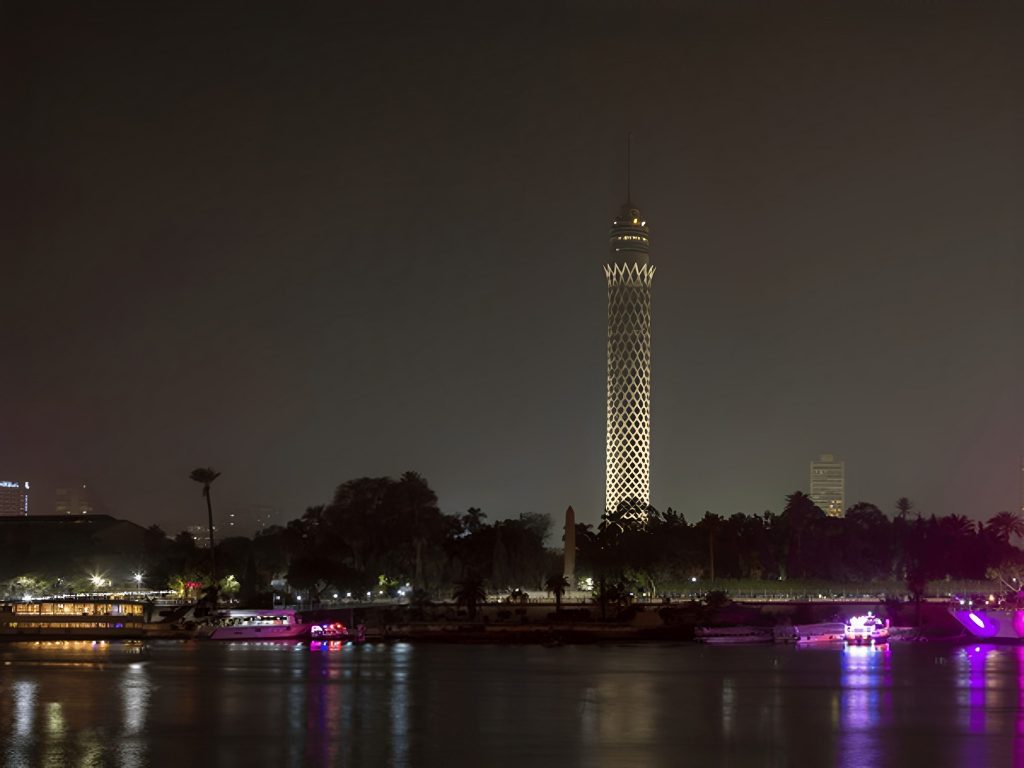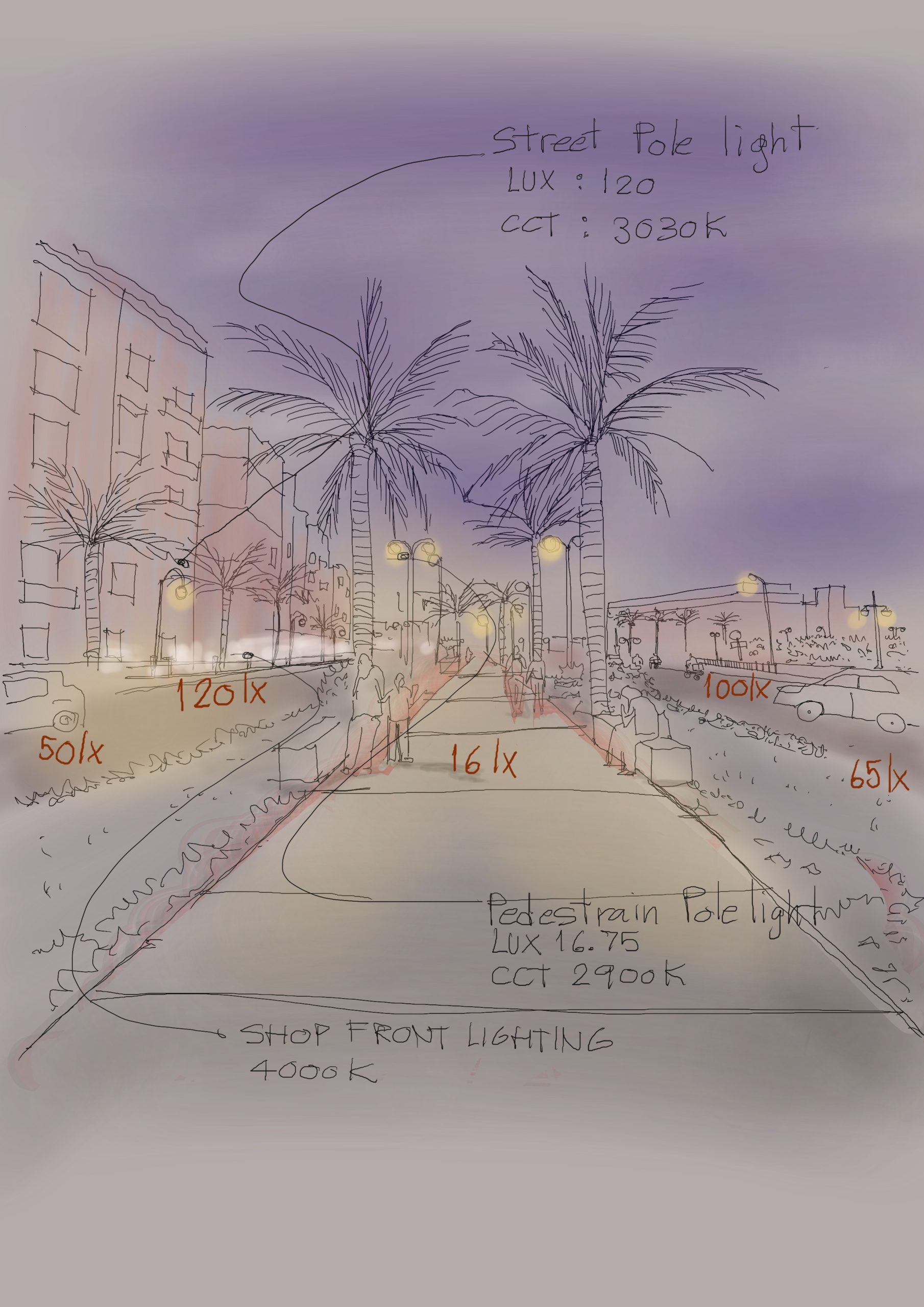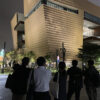2024.10.31-11.3 Makalin Wongchinchai + Stell Li

Egypt, land of secrets, a place full of history, mystery and amazing stories. We wanted to see not only the
famous pyramids, but also a lot of interesting cities and lightings in the night. To explore the lighting in Egyptian daily life, we chose to visit two main cities in Greater Cairo Area for four days.
■Introduction
Egypt, one of the world’s oldest civilizations, is home to the pyramids, deserts, the Nile, and its vibrant capital, Cairo, where ancient and modern worlds meet.
To explore this one of the most historical countries in the world, we chose to visit two main cities in Greater Cairo Area —Cairo (the captial city of Egypt) and Giza (with Memphis and its Necropolis – the Pyramid Fields from Giza to Dahshur ).
As the sun sets over the city, Cairo & Giza transforms into a dazzling display of lights and enchantment. The bustling streets come alive with vibrant energy. As locals and visitors alike gather in cafes, shisha lounges, and bazaars, embracing the rich Egyptian culture that thrives well into the night, we surveyed lightings on Cairo & Giza’s daily life.
■Cairo


The Khan el-Khalili market has always been a hub of trade and commerce since it was established in 14th century. Walking in this maze-like narrow streets was like taking a journey back in time.
During the day, the sunlight was intense. When the sun shines through all kinds of awnings, the streets were covered with rich colors.
However, it is when the night falls that the light magic happens. When every entrance arch gate was illuminated by warm glows, the streets were still dark, yet the shops came alive with uiquely styled lighting. For instance, Islamic lanterns hanged over the narrow paths, while stores selling distinctive lighting fixtures showcased colorful alabaster lamps.
Some shops simply had cool-toned LED strips draped over their canopies, casting a white light on their goods. At that moment, the ancient market transformed into a dazzling spectacle of shimmering light.
■Greenlight on AI-Hussein mosque
While walking in the bustling and lively market at night, what aroused our curiosity the most was a nearby spire. Its pencil-like shape, illuminated by warm light, accentuated its sharp ascent. Uniquely contrasting with the warm yellow tones on it was a vibrant green light. It was so striking that we could see it clearly from a distance.
Driven by the curiosity, we asked the locals about it, only to learn that green stood for good, harmony, peace, and vegetation. Green sustained life and promised protection and happiness. As a result; green was linked to Osiris. They like green.



■Tunnel
lit by just a few simple LED fixtures. Perhaps there weren’t enough lights, or maybe they lacked sufficient power. The entire passage felt dark and desolate, with only the entrances illuminated by strong sunlight.
Walking through the streets of Cairo, my first impression was of the brick-yellow buildings stretching to the skyline. The minarets which could be seen everywhere, were also in a sandy hue. Sheep grazed on the rooftops, while the markets thrived below. A large area of unfinished brick buildings might just face a city
park — a lively and happy greenery place in the desert. The buildings were mostly in square shape, with small window. In the night, there was nothing to light up the residential buildings, only the warm lights would stream through those small windows and form random lighting textures on the wall.
■Night view along Nile River
One of the best views to see Nile river in the night must be Qasr El Nil bridge. It is an icon of Nile River and connects the main business and economic of both sides. Standing on the bridge, we can see the colorful lighting of the cruises floating above the river. Most of the tall buildings on both sides of the river were hotels.
The facade lightings were simple and efficient, using uplight for the architectural features and a bright front-lit light for the hotel’s name.



However, this iconic bridge didn’t appear to be a tourist spot. The uplights for the sculptures were broken. Poles on the bridge seemed quite old and some were not working. It was dark and full of people walking there, which made it diffcult to see others.
When we wandered along the river bank, we passed a quiet and cozying park, Al Andalus Park. At first, we thought it was a private place of the hotel nearby, because of the elegant lighting in the park, like the exquisite lanterns, efficient tree uplight, harmoney light colors.
To our surprise, it is a city park opening to the public, but no one was there.
We walked through many public areas where people were sitting and relaxing in the night.
We noticed that they prefered a darker place rather than near the lights. They would sit and chat on the bench away from the street lights. They were enjoying the dark night.


■The Egyptian Museum
The Egyptian Museum in Cairo, designed by French architect Marcel Dourgnon, is the Middle East’s oldest archaeological museum.
Its neoclassical limestone design features a grand facade, symmetrical layout, and spacious atrium, evoking ancient temple grandeur. The two main wings house collections spanning Egyptian history, with high ceilings and spacious halls enhancing the display of its artifacts.



The lighting within the Egyptian Museum plays a crucial role in showcasing the artifacts while preser ving their integr it y. Natural light floods the central atrium through large windows, creating a welcoming and vibrant atmosphere. The carefully balanced artificial lighting complements the natural light, allowing for optimal viewing conditions without causing damage to the delicate ar tifacts.
However the overall lighting was quite dark. It was good to make use of the sunlight as much as possible, but it might be hard to keep the glass clean in the sandy air.
During the night walk, we were impressed by its facade lighting. The historic building transformed into a breathtaking spectacle thanks to the facade lighting.
T he facade of the Egyptian Museum is characterized by its neoclassical elements, incuding grand column sandintricate stone carvings. Speical attention is given to these architectural details through strategic illumination. Soft, warm LED lights are used to wash the facade in a gentle glow, acentuating the texture of the stone and the elegance of the builds structure without overpowering its historical intricacies.
The museum not only stands as a monument to the past during the day but also transforms into a stunning visual landmark at night.

■Giza Pyramids
The Giza Pyramids, located on the outskirts of Cairo, are some of the most iconic and enduring symbols of ancient civilization. Constructed during the Fourth Dynasty of the Old Kingdom, around 2580 to 2560 BCE, the most famous of these structures is the Great Pyramid of Giza, built for Pharaoh Khufu. It is one of the Seven Wonders of the Ancient World and the only one to remain largely intact.
The pyramids served as monumental tombs, encapsulating the ancient Egyptians’ beliefs in the afterlife. They were meticulously designed to protect the pharaoh’s body and possessions from tomb robbers and the elements. Over the centuries, the Giza complex also includes the Pyramid of Khafre and of Menkaure, along with the Great Sphinx, which further illustrates the grandeur of this ancient site.
■Pharaoh’s tomb
The Pharaoh’s tomb within the Giza Pyramid complex, particularly the Great Pyramid of Khufu, is a emarkable testament to ancient Egyptian civilization. Visitors can explore a series of chambers and passageways, leading to the King’s Chamber, where Khufu’s sarcophagus once lay. The intricate design features massive granite stones and walls adorned with hieroglyphics that reflect the Pharaoh’s divine status and his journey to the afterlife.
As you step into the tunnel, only a few lanterns made of alabaster illuminate parts of the path.
The tunnel is narrow, with some sections requiring two people to turn sideways to pass each other. Climbing up and down through the dimly lit passageways, surrounded by the warm glow of the soft yellow lights, one cannot help but immerse oneself in the echoes of a past civilization.



■Giza Pyramid Light Show
The Giza Pyramids have also been enhanced by modern technology through the “Pyramids Sound and Light Show.” Initiated in the 1960s, this show intricately weaves together narration, music, and striking lighting effects to recreate the history and grandeur of the pyramids.
The event takes place in the evenings, with visitors gathered to witness the pyramids illuminated against the night sky, offering a vivid glimpse into ancient Egyptian civilization.
The show combines ancient Egyptian history with modern storytelling techniques, immersing visitors in the cultural significance of the pyramids. It has become a staple for tourists, providing an engaging way to experience the site after sunset.

From our survey, it is evident that the lighting fixtures are not installed properly, making them susceptible to damage by the public.
While we understand that the lighting shows occur only about four days a week, there is a need for better installation practices, whether for permanent or temporary setups.
Ensuring that the fixture s are installed correctly will help prevent damage and enhance the overall experience for everyone.
Many visitors praise it for its breathtaking visuals and the aptivating storytelling that brings ancient history to life. The stunning illumination of the pyramids creates an aweinspiring atmosphere, allowing viewers to appreciate these ancient wonders in a new light.
■Interviews
In our exploration of public lighting in Cairo and Giza, we interviewed local residents to understand their perspectives on nighttime illumination in the city and how it could be improved.
From ourinterview with Mohamd Abd Salam Fared, a local resident and the owner of a perfume shop in Cairo, he expressed a preference for warm-colored lighting, which he finds more comfortable for the eyes. He believes that warm lighting complements Egyptian architecture and creates a relaxing and enjoyable atmosphere in the streets at night.
Mohamed Fayed, a Giza native and hotel manager, also shared his thoughts. He feels that the current level of public lighting in Giza is adequate. Like Fared, he prefers warm lighting that is not overly direct, as bright spotlights can create glare.

■Conclusion
Overall, our inter views reveal that most residents are satisfied with public lighting, particularly in functional areas, and they favor warm-colored lights. However, there is a desire for more attractive lighting options, especially in tourist areas, as Egypt relies heavily on tourism for its economic stability.
Our survey indicates that Egyptians enjoy public spaces, such as parks and bridges, and appreciate the minimal light pollution that exists.
The focus has been on enhanc ing only necessary lighting in important locations.
That said, maintenance of the existing lighting infrastructure is crucial. Many lights are damaged or poorly maintained, and ensuring that these fixtures remain functional and aesthetically pleasing would significantly enhance the nighttime experience in these cities. By addressing these aspects and involving local communities in the planning and implementation of lighting, we can create a more inviting and enjoyable environment for both residents and visitors.















